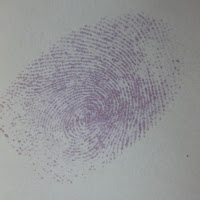Tuesday, November 22, 2011
Hair/Fiber: History
- First paper on hair analysis was published in 1857 in France
- In 1938, a comparison microscope was used for side-by-side analysis for a crime scene
- This method of hair analysis helped solve the murder of an 8-year-old girl in the same year
- First person was convicted of murder on neutron activation analysis in 1958
- Though there isn't much information on the history of hair and fiber analysis, it's still used as an importanat method of solving criminal investigations today
Wednesday, November 16, 2011
Fingerprinting: Procedures for Collecting/Lifting Prints
There are three common lifting methods for fingerprints:
Hinge lifters-
Rubber lifters-
Cellophane Tape-
Hinge lifters-
- Come in lots of color backgrounds (for visualization of prints with different powders)
- Placed on print and pressed evenly
- Lifted print is covered with hinged cover and is protected from scratches and dirt while being retained in original form
Rubber lifters-
- Plastic cover is removed fast so no lines are left on top
- The adhesive side of tape is applied to powdered print and pressed evenly
- Peel the tape away from surface
- Plastic cover is replaced on tape over print to protect it
- Print appears in it's negative (opposite) form
Cellophane Tape-
- For surfaces that aren't flat
- Attaches to contours to avoid bumps
- A bit of tape is folded over to use as tab for handing
- Print area is covered about an inch beyond in the other direction
- Gently rub tape over print
- Once in place, print is lifted by pulling roll away from surface
- Quickly apply tape to card and cut away excess
- Lifts prints in correct position (not reversed)
Fingerprinting: Techniques/Chemicals to Develop Prints
- Developed with application of powder
- Picked by best contrast to background
- Black is applied to white surfaces while grey/silver is applied to dark surfaces
- Grey/Silver is also applied to mirrors & polished surfaces (because they photograph black)
- Black powder is composed of black carbon or charcoal
- Grey/silver is composed of mainly aluminum dust
- Applied with fiberglass/camelhair brush
- Stick to residue (like body oils)
- Another powder is the magnetic-sensitive which can be spread with magnet brush (Magna Brush)
- Decreases chance of damaging print because brush doesn't have bristles that touch the surface
- Florescent powders can be used for the use under ultraviolet light
Fingerprinting: Shapes/Patterns of prints
Double Loop--There is an “S” shape somewhere in the print
Central Pocket Loop-- Un-circular spiral within the print, similar to the plain whorl but less circular
Ulnar Loop—Lines, curves, and arches that enter at one side, turn, then exit the other side (open towards pinky)
Radial Loop—Lines, curves, and arches that enter at one side, turn, then exit the other side (open towards the thumb)
Tuesday, November 15, 2011
Types of Fingerprints: (impressions)
Latent Prints:
- Appear when hand touches surface and some moisture is transferred from fingertips to ojbect
- Leaves behind impression of friction ridge detail
- Not readily visible
- Florescent dye stains, powders & super glue fuming to record prints
- Appear when substance is coating the skin and transfer to a surface from that substance
- Ex: Blood, grease, ink, ect.
- Typically visible
- Photograph to record
Fingerprinting: History
In 1822, Gilbert Thompson (of the U.S. Geological Survey in New Mexico) used his thumbprint on a document to prevent forgery. This was the first known use of fingerprinting in the U.S. It was a receipt issued by Thompson to “Lying Bob” for 75 dollars.
In 1888, Sir Francis Galton (a British anthropologist) began his observations of fingerprints as a tactic for identification.
In 1892, Juan Vucetich made the first criminal fingerprint identification. He identified a woman named Francis Rojas, who killed her two sons (and cut her own throat to place the blame on someone else) She left bloody prints on a door post, which proved her as the murderer. Galton’s interest in fingerprinting was an aid in finding heredity and racial backgrounds. He was able to scientifically prove fingerprints don’t change throughout a person’s life and that no two prints are the same. He identified the characteristics on how prints can be identified and some of the same characteristics are still used today. (called Galton Details)
In 1903, The New York State Prison system began the first organized use of fingerprints for criminals in the U.S.
In 1905, The U.S. Army began using fingerprints and the U.S. Department of Justice form the Bureau of Criminal Identification in Washington, DC to offer a centralized reference assortment of fingerprint cards. Two years later the U.S. Navy started as well as the Marine Corps the next year. Over the next 25 years many law enforcement agencies joined in using fingerprinting as a means of personal identification.
By 1946, the FBI had 100 million fingerprints in manually maintained files and by 1971 there were 200 million cards. The automated fingerprint identification system (AFIS) split the flies into computerized criminal flies and manually maintained civil files. Many of the manual files were repeats, but the records represented somewhere around 25 to 30 million criminals and an unknown amount of people in the civil files.
In 1977 the world’s first certified team of fingerprint experts called the IAI’s Latent Print Certification Board. They’re considered by many identification professionals to be a measurement of excellence.
In 2005, INTERPOL’s Automated Fingerprint Identification System repository exceeds 50,000 sets of fingerprints.
Now, in 2011 the largest AFIS repository in the U.S. is operated by the Department of Homeland Security’s U.S. Visit Program, which has over 100 million fingerprints. All U.S. states have their own AFIS databases with fingerprint records stored. Fingerprints are used very commonly in many criminal cases today.
Tuesday, November 1, 2011
Subscribe to:
Comments (Atom)
























